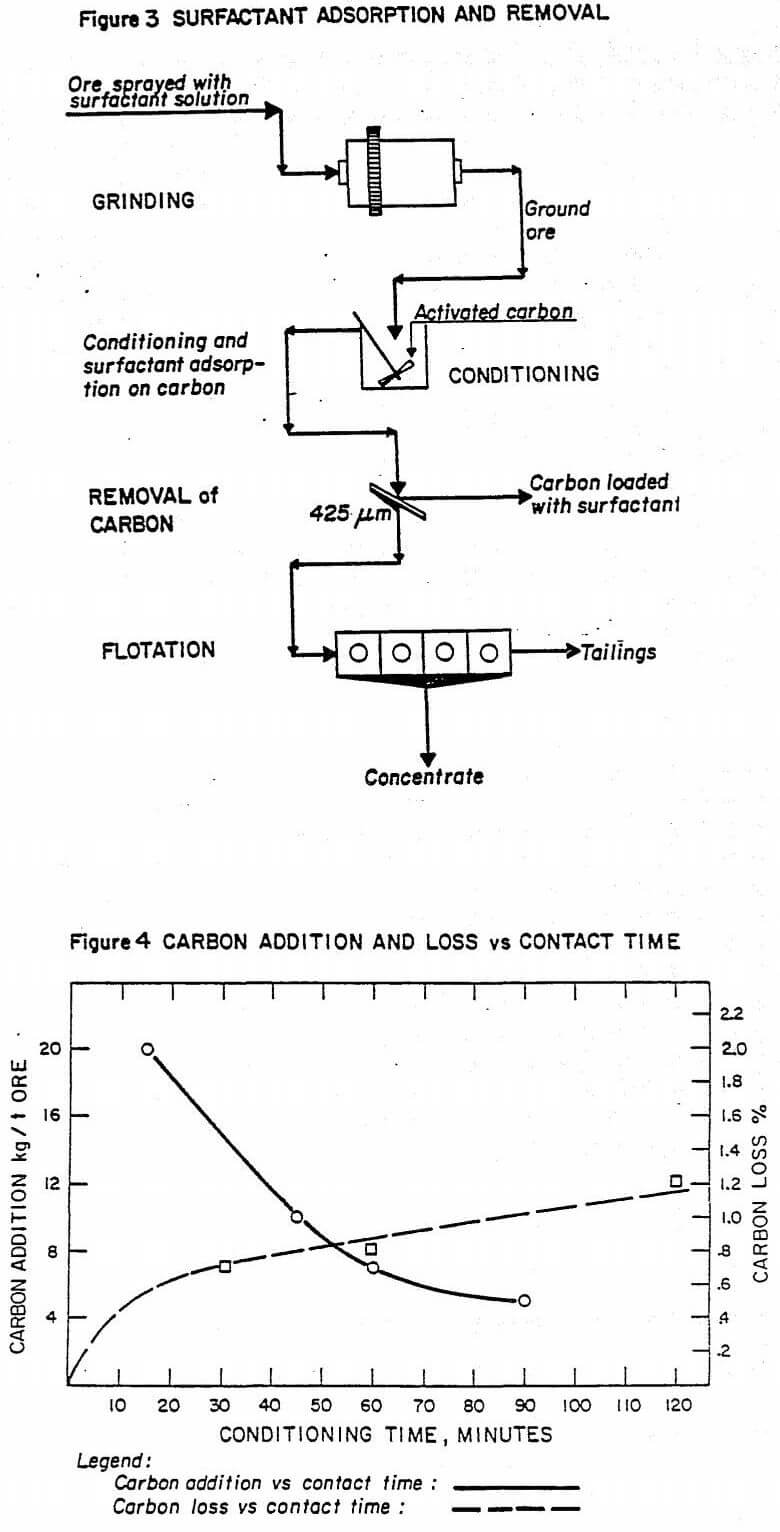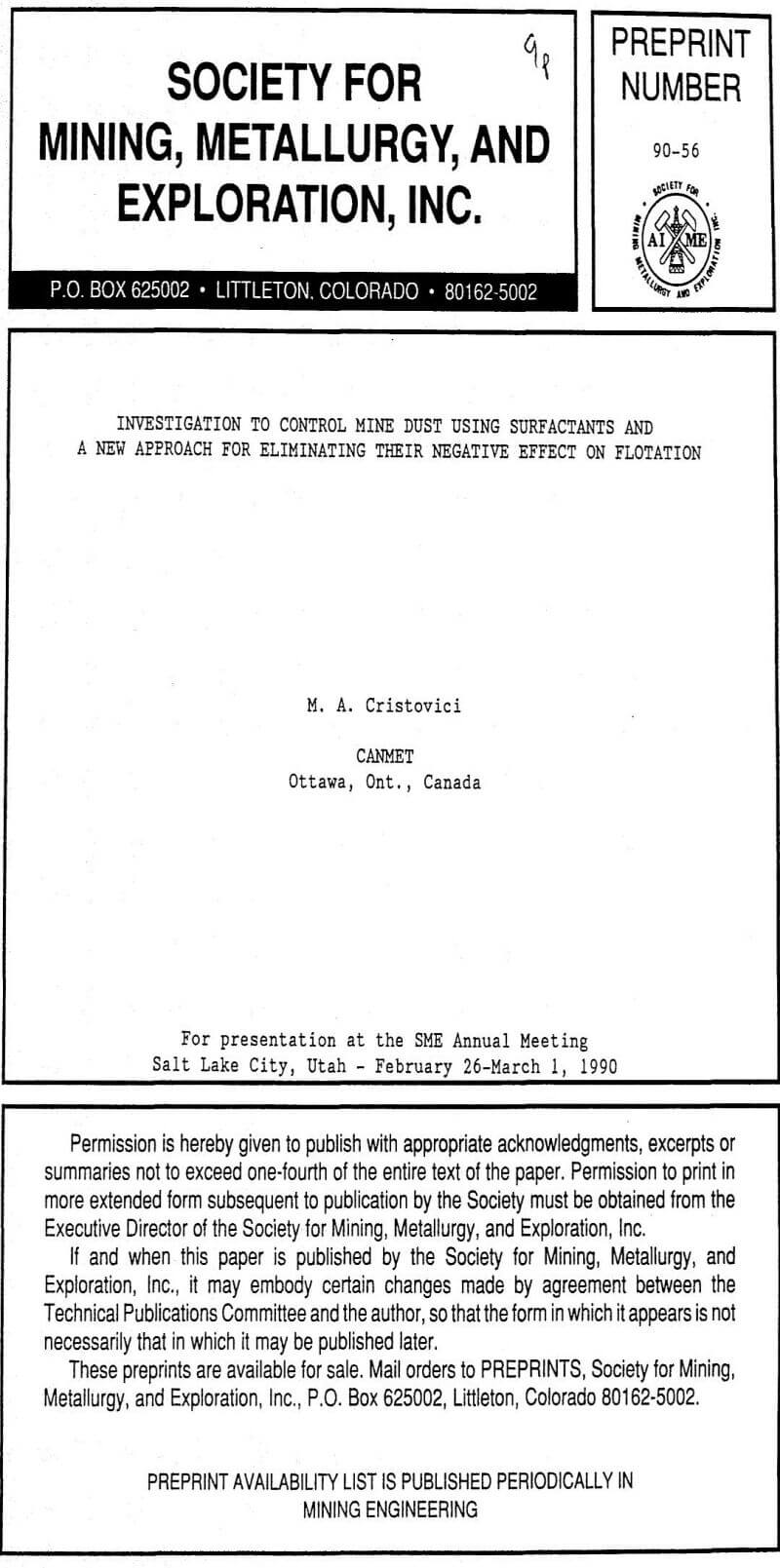Dust measurements in mines clearly indicated that the major mineral dust exposure is due to loading and transport of the ore from the mining areas. One approach to the solution of this dust problem is the application of water sprays to reduce dust dispersion. Wetting of broken rock is very effective in preventing fine dust from becoming airborne by binding it to the larger lumps.
The surfactants are known to be able to reduce the surface tension of the water, facilitating the wetting and the suppression of the sulphide ore dust, but on the other hand the flotation of the sulphide ore is susceptible to interference by surfactants.
A laboratory study was initiated to examine the effects of surfactants on the wetting of sulphide ore dust.
Numerous surfactants were investigated for their properties and their ability to suppress dust and some of them were selected as suitable dust suppressors.
However, further testwork indicated that the presence of the wetting agents in the ore adversely affected the efficiency of minerals separation in the flotation process. A research program has begun to investigate the possibility of eliminating the detrimental effect of the surfactants on flotation results.
Several possibilities were explored and finally a technique was developed by which the surfactants used as dust suppressors were adsorbed on activated carbon and removed from the slurry prior to the flotation process.
- Experiments to evaluate the surfactants properties
- Wetting ability
- Foaming
- Selection of potential dust-suppressing agents
- Effect of wetting agents on flotation results
- Investigation to annihilate the negative effect of the wetting agents on flotation
- Carbon adsorption procedure
- Carbon addition after the grinding stage
For each carbon addition an optimum conditioning time was determined, conditions under which the copper grade and recovery in the flotation concentrate were similar to those obtained when no surfactant was sprayed on the ore.
The same efficiency in surfactant adsorption could be obtained by using a small amount of carbon for a long conditioning time or a large carbon addition for a short contact time.
However, the carbon loss was in direct relation with the duration of contact time. Since carbon can be recovered and reused it was considered more important to minimize the carbon loss rather than the carbon addition. Therefore the selected conditions were: 20 kg/t carbon addition for 15 minutes contact time. Under these conditions carbon loss was insignificant.
Also, it should be noted that the required amount of carbon and contact time to annihilate the negative effect of surfactants was determined under excessive addition of wetting agents, i.e., 50 L, solution 2%, per tonne or ore. However, a more realistic spray of wetting agents to suppress dust would be only 10 L/t.
Several tests were carried out to determine the required carbon addition to annihilate a surfactant spray of 10 L/t. The contact time for all these tests was kept to a minimum.
The data of this series of tests showed that under 10 L/t surfactant spray even 1 kg/t carbon addition was enough to decontaminate the ore and to restore the copper grade in the flotation concentrate. The carbon loss for 1 kg/t addition and 15 minutes contact was undetectable.
Another important element to be considered, in minimizing the cost of surfactant use for dust control and surfactant decontamination before flotation, is the possibility of reducing the wetting agent concentration in the spray solution below 2%. For practical purpose the surfactant removal testwork was carried out using 2% solution of wetting agent.
The optimum concentration of surfactants in the water spray for dust suppression will actually be determined during the experiments that will be carried out in underground mines.
It is obvious that a decrease in surfactant concentration or in the amount of solution spray will result in a corresponding reduction of the cost to annihilate the (negative effect) of the wetting agents.
- Among the wetting agents examined several surfactants were selected as potential dust suppressors .
- Surfactants used as wetting agents adversely affected the flotation results, particularly the concentrate grade.
- A carbon adsorption technique could eliminate the detrimental effect of the surfactants and restore the concentrate grade, even when excessive amounts of wetting agents were used.
- Under standard spraying conditions to suppress the dust (10 L solution/t of ore and 2% surfactant 8A04 concentration) an addition of 1 kg activated carbon/tonne of ore for 15 min contact time was required to adsorb the surfactant and eliminate its detrimental effect on flotation results. The carbon loss was insignificant.
- The process to eliminate the surfactants by adsorption on activated carbon is very simple and requires minimal changes in the plant flowsheet. A carbon adsorption unit has to be inserted between grinding and flotation. Also, to regenerate the carbon a kiln must be installed in the plant.

